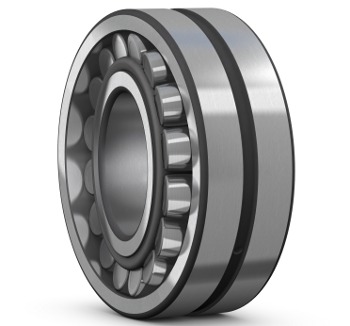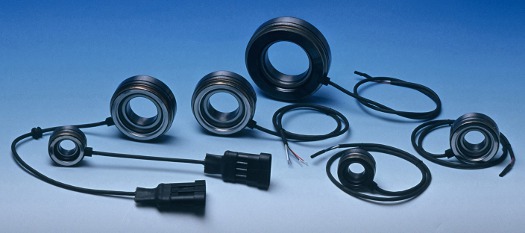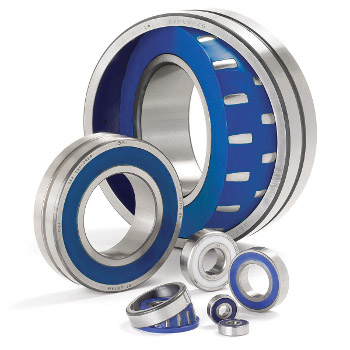 |
| July 17, 2018 | Volume 14 Issue 27 |
Designfax weekly eMagazine
Archives
Partners
Manufacturing Center
Product Spotlight
Modern Applications News
Metalworking Ideas For
Today's Job Shops
Tooling and Production
Strategies for large
metalworking plants
Innovations in the world of bearings
By Brian Dahmer, SKF USA Inc.
Getting the best performance from rotating equipment is a necessity for any industrial operation on the road to optimized efficiencies and productivity. While a variety of influences will govern performance throughout a machine's life cycle, rolling element bearings are among the critical precision components playing dynamic roles.

While bearings in rotating equipment primarily serve to support shaft loads, reduce friction with rolling elements, and provide shaft location and system rigidity, they can contribute so much more. For design engineers, specifying the right bearing for the right application can elevate anticipated equipment performance to higher levels -- and every innovation in the design, engineering, and materials for bearings expands the options. Examples abound.
Specialty protective coatings
Innovative coatings have been developed to help protect bearings and include coatings for wear resistance and coatings for insulation against stray electric currents.
Bearings can be subject to wear for any number of reasons, whether due to poor lubrication conditions (associated with high temperatures and/or low lubricant viscosities), sudden variations in load or speed, and/or standstill vibration. All can lead to dramatically shorter bearing (and rotating equipment) service life over time.
As a safeguard, a patented wear-resistant carbon coating, applied by the manufacturer, can be specified for a bearing's rolling elements and/or raceways. The coating, only a few microns thick, covers the contact surfaces using a specialized process ideally suited for bearings. The resilience of the bearing steel is retained, and the surface hardness of the steel is increased substantially compared with standard bearing steel grades.
Specialty coatings with insulating properties have also been formulated. These protect against stray electric currents in variable-speed electric motor and generator applications, where bearing damage can result from the passage of AC or DC electric current whenever the current uses a bearing as its path to ground.
Such stray currents can damage the contact surfaces of a bearing's rolling elements and raceways and rapidly degrade bearing grease. Once this "electric arc bearing damage" has begun, excessive vibration, increased heat, increased noise levels, and reduced effectiveness of lubricant will combine to shorten a bearing's service life.
Designers can "insulate a bearing from the outside" by specifying a very thin aluminum oxide coating to form a barrier against electric arcing and subsequent erosion of the bearing rolling surfaces. The coating is applied by the manufacturer, either on a bearing's outer ring or inner ring using a spraying technique and then sealed with a resin to protect against the conductive effects of water and moisture. Standard insulating coatings can withstand voltages up to 1,000 VDC or can be developed for voltages as high as 3,000 VDC.
Advances in materials
Bearings routinely exposed to highly corrosive elements and/or repeated chemical wash-downs will be unable to withstand the constant attacks from corrosive media over time (especially without proper sealing or shielding). This dilemma has led to the breakthrough development of highly corrosion-resistant steel -- shown to outperform conventional grades of stainless steel -- and has expanded the material world of bearings.
High Nitrogen Corrosion Resistant (HNCR) steel exhibits superior corrosion and wear resistance compared with 440C Series stainless steel and superior corrosion resistance and equal wear characteristics compared with 52100 Series stainless. Bearings featuring inner and outer rings made from HNCR steel can deliver unequaled protection in extreme corrosive environments without sacrificing hardness and fatigue life.

Bearings with specialty protective coatings applied by the manufacturer can be specified for enhanced wear resistance or for their insulating properties against potential stray electric currents.
Specifically, the combined presence of nitrogen and high amounts of chromium in HNCR steel imparts superior corrosion resistance. HNCR steel also offers greater material "cleanliness" than 440C and 52100 steels and greatly reduces the amount of sulfides, aluminates, silicates, or globular oxides in the steel. The lack of these non-metallic contaminants contributes to enhanced bearing life, as does the extremely homogeneous structure of HNCR steel.
In another example of material advances, hybrid bearings integrating rolling elements made of bearing-grade silicon nitride (instead of steel) can substantially improve reliability and robustness -- notably in tough applications, such as pumps in the oil and gas and hydrocarbon process industries. Hybrid bearings additionally will insulate against stray electric currents.
Bearing-grade silicon nitride, an engineered ceramic material, offers a uniform and clean microstructure that is extremely hard and 40 percent of the density of bearing steel. As a result, rolling elements weigh less and exhibit lower inertia, which reduces stresses on a bearing's cage during rapid starts and stops and significantly lowers friction at high speeds. Lower friction translates to cooler running and longer lubricant service life.
The dissimilar materials of the steel rings and ceramic balls also results in better bearing performance under poorly lubricated and/or contaminated conditions. The very smooth and hard balls cannot adhere to the ring material like steel balls can when insufficiently lubricated, leading to reduced friction and longer life. When contaminated conditions exist, the very hard balls smooth the dented surfaces of the raceways, reducing stress concentrations and extending life.
"Intelligence" capabilities
Sensor-bearing units (integrating a sensor, an impulse ring, and a ball bearing) introduce technologies delivering precise information on the motion status of rotating or axially traveling machine parts. Relevant applications include electric motors, linear actuators, steering systems, conveying and handling systems, and automation equipment, among others.

Sensor-bearing units introduce technologies delivering precise information on the motion status of rotating or axially traveling machine parts.
Such "intelligent" bearings can sense the number of revolutions, speed, direction of rotation, relative position/counting, and acceleration or deceleration. In the application, the bearing unit's impulse ring moves past the stationary sensor ring when the inner ring rotates, generating a magnetic field of changing polarity. The sensor outputs a pulse, based on the number of polarity changes per second. The sensor output signal is then transmitted via connecting cable and used to generate the required application-specific information.
Unconventional lubrication
For most typical bearing applications, standard greases or oils will serve to adequately lubricate a bearing's rolling elements and raceways. However, in instances of extreme or especially demanding operating environments, conventional lubricants may not be able to make the grade, adversely impacting both the performance and lifetime of a bearing.
In addition, where inaccessibility to bearings for re-lubrication may be an issue, keeping bearings properly lubricated will present challenges. Bearings located in hard-to-reach (or even dangerous) locations essentially can make re-lubrication procedures difficult or virtually impossible.

Non-traditional bearings lubricant technologies include Solid Oil bearings as alternatives for applications in demanding operating environments or where access may be an issue for lubrication.
Such issues have led to the development of "non-traditional" bearing lubricant technologies, notably Solid Oil bearings.
Solid Oil bearings are lubricated with a polymer material featuring a porous structure (millions of micro-pores), which is saturated with high-quality synthetic lubricating oil. The pores in the polymer material are so small that the oil is retained in the material by surface tension.
In service, the polymer material employs the bearing's cage as the reinforcing element. When the bearing rotates due to the pressure of the rolling elements against the polymer pack and frictional heat from bearing operation, the oil seeps into the created gaps and onto the rolling elements and raceways, providing good lubrication right from the start. When operation stops, excess oil is re-absorbed, ready to be released again when needed.
The polymer matrix contains two to four times more lubricating oil than standard grease-filled bearings, which often allows the life of the lubricant to exceed the desired service life of the bearing. With few exceptions, most standard bearings can be specified as Solid Oil bearings.
Transformative supplier resources
Any discussion about innovations in the world of bearings naturally extends to suppliers and the underlying support they can marshal in the early design stages and all the way through manufacturing, delivery, and follow through with technical and maintenance expertise.
In our case, innovation is exemplified by "world-class manufacturing" as a strategic priority focusing on the end-to-end value chain from suppliers to customers and on digitally connecting this chain to increase transparency for better, faster, and more effective decisions and actions. In short, the aim is to achieve zero-defect delivery at the right time and at the lowest possible cost in a completely safe environment.
This dedicated strategic approach effectively cultivates an array of interrelated design- and manufacturing-related resources available to designers during the specification process and ultimately contributing to the success of any bearing application.
About the author
Brian Dahmer is Director of Engineering Experts at SKF USA Inc. Contact him at
brian.p.dahmer@skf.com or +1 267-436-6517. www.skfusa.com
Published July 2018
Rate this article
View our terms of use and privacy policy
